ANNUAL REPORT 2013-2014: CORPORATE OPERATIONS
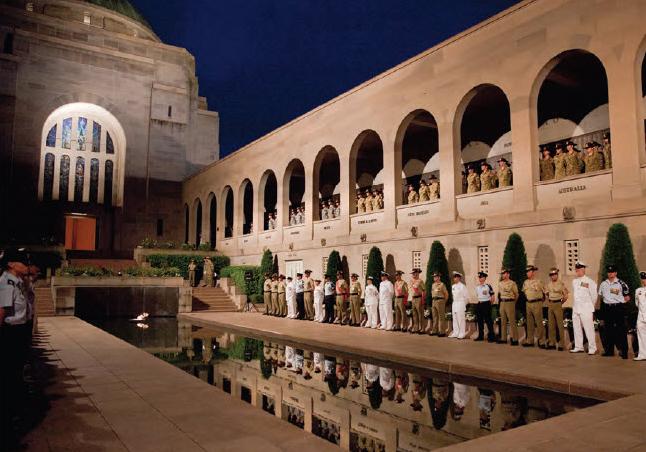
The Australian Defence Force Academy Napier Waller Reflection Ceremony, held in the Commemorative Area of the Australian War Memorial
This past year has been a busy and invigorating one. The Centenary of the First World War is upon us, and I am proud to report that we have taken significant steps in preparing for its commemoration.
Although the nation federated in 1901, it was not until the cataclysm that unfolded from 1914, through building the AIF and sending young Australians overseas to fight in our name, in an Australian uniform, and with an Australian flag, that Australia had its own story.
Progress on the redevelopment of the First World War Galleries has been excellent. Primary works were completed on time and under budget, and secondary works, including exhibition fit-out, have progressed well during the year. Procurement for tertiary works has been completed and work has commenced, including for audio-visual production. The quality of work to date is impressive and commensurate with the importance and profile of the project in general. The new galleries will feature the National Collection in more accessible and interesting ways and will reposition the superb dioramas as features in the telling of our story. The project budget comprises $28.7 million provided by government; $2.67 million allocated from the Memorial's existing capital reserves; and $1 million sponsorship from BHP Billiton Sustainable Communities. I warmly acknowledge the generous support of both the federal government and BHP Billiton Sustainable Communities for this centrepiece project.
A logo was launched in February 2014 for use in all the Memorial's centenary projects. The Memorial has also licensed the use of the centenary logo for sponsors, partners, and community commemorative projects. The Memorial is managing two programs to develop commemorative merchandise - one on behalf of government and one for the Memorial. Products include apparel, stationery, publications, home-wares, gifts/ memorabilia/reproductions, and corporate gifts. We have also collaborated with the Royal Australian Mint and Australia Post to develop commemorative noncirculating coins and stamps under a licensing program. Some of the merchandise was released for sale during April 2014.
The implementation of enhanced architectural lighting to the Memorial building at night, particularly of the Hall of Memory and the stained glass windows, will be completed by August 2014. Recording of the Roll of Honour Soundscapes, featuring the voices of schoolchildren from across the country reciting the name and age at death of each of the 62,000 Australians listed on the First World War Roll of Honour, will be launched in August 2014. Our partners are ABC Radio and Google (which has produced a web-based app for use by schools). The voices of these young Australians will be heard in the First World War cloisters throughout the centenary period.
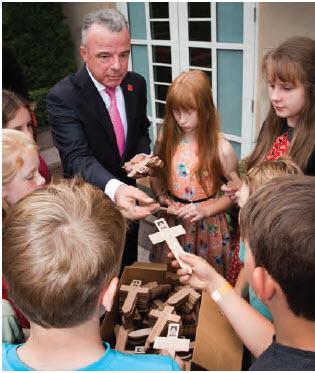
Memorial Director Dr Brendan Nelson discusses the significance of the Commemorative Crosses Program with visiting school students.
The Roll of Honour Projections project will see each of the 62,000 names from the First World War Roll of Honour projected onto the Memorial building immediately beneath the Hall of Memory dome. Each name will appear for 30 seconds on up to 30 occasions over the four years of the centenary period from August 2014. The Commemorative Crosses project involves schoolchildren who visit the Memorial inscribing individual crosses with their personal comments to the soldiers who gave their lives in war. The crosses are then delivered to Australian ambassadors and high commissioners in 39 countries for placing on Australian war graves and memorials. It is anticipated that around 15,000 crosses will have been inscribed by Remembrance Day 2014.
A partnership between the Memorial and production company Eyeworks, on behalf of Foxtel's History Channel, will deliver a five-part observational documentary series. The series follows the First World War Galleries' redevelopment, explores behind the scenes of Memorial operations, and investigates our First World War history through the stories of Australian soldiers and families. The series is presented by acclaimed television history presenter Neil Oliver. It is expected the series will screen on the History Channel from November 2014. The Memorial is also working with the Australian National University to deliver the Gallipoli 1915: a century on military history conference from 18 to 20 March 2015.
The first 100 collections for Anzac connections were released in December 2013 and were formally launched on 17 April 2014. A further 50 collections have been added since the launch. The contents of the collections range from diaries and letters by commanders, nurses, Indigenous Australian soldiers, VC recipients, and many ordinary Australians caught up in the extraordinary experience of war. These are delivered online with simple, intuitive navigation. Prime Minister the Honourable Tony Abbott launched the digitisation of General Sir John Monash's remarkable personal letters and diaries in June. The Memorial will progressively add collections to the site over the centenary period.
The exhibition-in-a-box concept has been re-scoped to become a small photographic exhibition entitled A camera on Gallipoli. This exhibition will feature a selection of the remarkable images taken by Sir Charles Ryan in Egypt and on Gallipoli in 1914 and 1915, presenting some of the most graphic and important photographic images from the campaign. It will be suitable for regional and remote venues, community groups and historical societies, schools, libraries, RSLs and other service associations, Australian Defence Force bases, airports, and town or community halls.
Recruitment of the project team for the Anzac Centenary Travelling Exhibition commenced with the appointment of Major General Brian Dawson (Retd) AM CSC as the Executive Manager; and Imagination (Australia) as the Creative Director. The final scope and form of the exhibition is subject to available funds both government and corporate.
The National Remembrance Day Ceremony was conducted in November 2013 with just over 2,200 people in attendance despite the gloomy weather, including Her Excellency Ms Quentin Bryce AC CVO, the Governor-General of the Commonwealth of Australia, and Senator the Honourable Michael Ronaldson, the Minister for Veterans' Affairs, representing the Honourable Tony Abbott MP, Prime Minister of the Commonwealth of Australia. Former Prime Minister the Honourable Paul Keating delivered the commemorative address on what was also the twentieth anniversary of his towering eulogy to the Unknown Australian Soldier. Before the National Ceremony, family members, representatives from the Australian Defence Force (ADF), the Chairman, and I were in attendance at a ceremony for the addition of two names to the Afghanistan Roll of Honour. The Hall of Memory enhancements to commemorate the twentieth anniversary of the interment of the Unknown Australian Soldier were completed for Remembrance Day. A bronze panel of Mr Keating's eulogy at the 1993 interment ceremony, which replaced the printed version previously in use, was unveiled by him on Remembrance Day. Onto the bevelled edge of the northern end of the tomb has been engraved the words:
HE IS ALL OF THEM
AND HE IS ONE OF US
The 99th anniversary of the Anzac landings was commemorated with the Dawn Service and National Ceremony on 25 April 2014. The new elements added to the Dawn Service last year were continued and expanded in 2014. The sound of the didgeridoo, played by Indigenous Able Seaman Boatswains Mate Darren Davies in the darkness from the parapet before the commencement of the Dawn Service, was truly haunting. The record audience was able to view the service, including the Dawn Service address by Corporal Ben Roberts-Smith VC MG, on three large screens located in the grounds.
The attendance of Their Royal Highnesses The Duke and Duchess of Cambridge at the Dawn Service and the National Ceremony was a highlight, as were Australia's four living Victoria Cross recipients leading the veterans' march. Prime Minister Tony Abbott delivered the Commemorative Address, urging Australians to extend their focus to the tragedy and triumph of Australians on the Western Front. Following the National Ceremony Their Royal Highnesses The Duke and Duchess of Cambridge planted a Lone Pine sapling in the western lawn of the Memorial. The sapling was grown from the one planted in 1934 by Prince Henry, Duke of Gloucester. The final commemorative element for the day, the Last Post Ceremony, saw Corporal Daniel Keighran VC read the story of Private Thomas Anderson Whyte 10th Battalion, AIF, who died of wounds on 25 April 1915. A champion Adelaide rower, he had volunteered to row one of the boats ashore at Anzac Cove. He was 29 years old.
Attendance at the Anzac Day ceremonies has been increasing steadily over the years, with 37,000 for the Dawn Service and 25,500 for the National Ceremony this year. Even larger numbers are anticipated next year for the centenary of the landings on Gallipoli, and planning has commenced for a full weekend of commemorative events. As well as the traditional Dawn Service and National Ceremony, it is planned to broadcast the ceremonies on Gallipoli and at Villers-Bretonneux on large screens erected in the Memorial's grounds. Further, on a date later in 2015, a special commemorative performance will be staged featuring acclaimed Australian singer-songwriter John Schumann and a range of contemporary artists.
The personal stories told in the galleries and exhibitions at the Memorial are key to a strong emotional connection to our visitors. This has been eminently apparent in the new Afghanistan: the Australian story exhibition, where young and old, veterans and civilians alike, have laughed and cried at the powerful stories of still-serving personnel. The exhibition was opened on 6 August 2013 by Chief of Defence Force General David Hurley AC DSC, with approximately 300 people in attendance including the Honourable Kevin Rudd MP, then Prime Minister of Australia, and the Honourable Tony Abbott MP, then Leader of the Opposition.
Although some questioned why we would exhibit the story of a war not yet ended, I regard it as essential that the Memorial be part of the therapeutic milieu for those returning to a country that has little idea of what they have done in our name. More than 27,000 ADF personnel, Australian Federal Police, aid workers, and diplomats have served in Afghanistan over the more than a decade of our involvement. Their story needs to be told and, working with acclaimed journalist Chris Masters, we have combined objects, multimedia, and the veterans themselves to tell a powerful story.
Consistent with this, the Memorial has introduced a "soldiers in residence" program. Its objectives include providing army personnel with the opportunity to share their experiences in Afghanistan and on other operations with members of the general public. It enables them to promote awareness of the achievements of the ADF in the Afghanistan conflict. Soldiers have enjoyed working with staff behind the scenes in a number of areas across the Memorial, as well as engaging with visitors in the Afghanistan exhibition space. The program has been a great success and will be extended to include the navy and air force in late 2014. The positive impact on these soldiers and our staff has been immeasurable.
The inclusion on the Roll of Honour of those killed whilst on peacekeeping and non-warlike operations provoked considerable debate in the community and the media. This was not a decision made lightly by Memorial management and Council, but it was the right one. Commemoration of those who gave the ultimate sacrifice in operations considered peacekeeping and not warlike sits comfortably within the vision of the Memorial conceived by Australia's pre-eminent war historian Charles Bean in the depths of the First World War. Australia contributed to the first operation mandated and endorsed by the United Nations. It has done so on more than 60 occasions since, and it will certainly do so again. Australians have given their lives in the service of our nation over those six decades in circumstances in which they have been sent by successive governments on operations considered not to be "war". Thanks to them, we now live in a free world as free people. The distinction between death in "warlike" as distinct from "non-warlike" operations is to many Australians an abstract technicality creating different classes of ADF personnel in death. The Operational Service Roll of Honour panel was unveiled during a low-key but dignified ceremony on 30 August 2013. Several family members have subsequently expressed their deep gratitude for the manner in which the ceremony was conducted and their desire to return to the Memorial in the future.
An article in the Canberra Times just before last year's Big things in store exhibition described me as being "like a kid in a candy shop", and that is exactly what it is like for the thousands of happy visitors we welcomed to our Mitchell facility in September 2013. Thanks to our exclusive partner for the event, NRMA Motoring Services, it was a great day out for the whole family and an excellent opportunity for the public to see the rare objects in storage that can't be displayed as often as we would like.
Another special event, held on 23 February 2014, was Of animals in war, commemorating the roles that animals have played in support of Australia's war efforts. The all-day family event was an opportunity for the public to pay their respects for the invaluable contributions of animals in Australia's military history and to honour those who served, suffered, and died alongside our soldiers. The Commemorative Ceremony was followed by a range of indoor and outdoor activities such as talks from the Australian Light Horse Association and the Canberra Racing Pigeon Combine, whose members released some pigeons from Memorial grounds. Engaging public programs were run for the benefit of the whole family, including arts and crafts, and story time. The day proved to be popular with those who attended.
Other exhibitions that opened during the year include Salute: Canberra's military heritage, one of the Memorial's major contributions to the 2013 Canberra Centenary celebrations. It was opened by former Memorial Director Major General Steve Gower AO AO(Mil) (Retd) in August 2013 and looked at the long association the Australian military forces have had with Canberra as well as the impact of war on Canberra and Canberrans. Anzac voices is the temporary exhibition providing a First World War experience for visitors during the redevelopment of the permanent First World War Galleries. It is an evocative and emotive exhibition that brings the voices of the Anzacs to the visitor in a very personal and compelling way. The firsthand descriptions of the challenges faced by the Anzacs on Gallipoli, and on the Western Front at Fromelles and Pozières, give modern-day Australians an inkling of what it was truly like for the everyday soldier. We were very pleased to be highly commended for Anzac voice at the Museum and Galleries National Awards in May 2014.
Another worthy project has been the refurbishment and rebranding of the Terrace at the Memorial café. The café enhancements will improve the flexibility of the internal space of the café and provide visitors with additional seating choices and the option of interacting with multimedia components. The café will now be known as Poppy's, in recognition of the service and sacrifice of those who have served in Afghanistan. Poppy's is based on the recreational centre in Afghanistan which provided services to the Australian soldiers on duty in the Middle East. It was named after Trooper David "Poppy" Pearce, who was killed in Afghanistan in 2007. Trooper Pearce was nicknamed "Poppy" because the younger soldiers regarded him as a mentor and father figure. The Memorial's café enhancements will incorporate aspects of this experience, including a photograph of Trooper Pearce, the original Poppy's sign, and the boomerang and kangaroo sign mounted on the original Poppy's recreational centre in Tarin Kot, Afghanistan. These were brought back by the Prime Minister and presented to the Memorial. The result will be a café with an ambience consistent with being at the Australian War Memorial.
With the withdrawal of troops from Afghanistan, Memorial staff have been working closely with members of the ADF through the Collection Coordination Group (CCG) to ensure that the items identified by curators in Afghanistan are transferred to the Memorial. The CCG has also successfully produced the longest and biggest portrait commission ever undertaken at the Memorial. Nineteen servicemen and servicewomen representing the navy, army, and air force were photographed and interviewed before, during, and after their deployments to Afghanistan. The CCG was also instrumental in the deployment of a Memorial cinematographer to Operation Philippines Assist to record the humanitarian work undertaken by the ADF.
The important and ongoing work of developing and caring for the National Collection included acquisition of the Victoria Cross and medal group of Keith Payne VC OAM and the loaned Victoria Cross and medal group of Corporal Cameron Baird VC MG; the task force symbol of a kangaroo and boomerang from Poppy's recreation area in Tarin Kot; and two Protected Mobility Vehicles (Bushmasters), both damaged by Improvised Explosive Devices. Other key additions were a rare State of Victoria Permanent Infantry Officer's uniform, circa 1890; a rare collection of 13 French, German, Italian, Hungarian, Russian, and Polish First World War propaganda posters; and a hand-drawn map of the Lone Pine trenches, dated 28 November 1915, by Tom Oswald Butcher. One of the most fascinating donations is the set of 3,000 images from the No. 458 Squadron RAAF Association. In the late 1940s the association started gathering photographs and other memorabilia, and over many years has compiled these into two albums weighing 12 kilograms each. They were carried to every reunion in specially constructed green carriers made from parachute bags and will now be cared for in perpetuity by the Memorial.
The Chairman has provided an overview of the Memorial's financial position and I can only reiterate that good financial management practices are in place and we will continue to manage our operations within the available funding. As noted, this has meant a reduction in staffing for 2014-15 as well as a reduction in activities, notably the decision to not have an Open Day in 2015. Further staff reductions are forecast for 2015-16 and beyond. Some of these will be the natural result of preparatory centenary activities coming to an end and others will be the result of the ongoing efficiency dividend.
Council and management are of the firm belief that a diverse range of funding sources is the most secure way to fund the operations of the Memorial. We are very grateful to our generous supporters and partners, including BHP Billiton Sustainable Communities, Mr Kerry Stokes AC, Seven Group Holdings, the Seven Network, Boeing Australia, Qantas, Lockheed Martin, BAE Systems, Thales Australia, Kingold, RSL and Services Clubs, and the De Lambert Largesse Foundation. I also thank the federal government, the Department of Veterans' Affairs, and Minister for Veterans' Affairs Senator Michael Ronaldson for their ongoing support.
I thank Memorial Chairman Rear Admiral Ken Doolan AO RAN (Retd), and all members of Council for their highly valued oversight and strategic direction. Unfortunately, we saw the departure of three key members of Council during the year: Air Vice-Marshal Julie Hammer AM CSC (Retd), Ms Jane McAloon and Mr Kevin Woods CSC OAM. The government recently appointed Mr Les Carlyon AC and Ms Jillian Segal AM, and I welcome them both to Council.
Of course, all this would not have been possible without the talent, enthusiasm, and commitment of the Memorial's staff and our many volunteers in their various capacitie. I gratefully thank them and acknowledge their contributions. It is a great pleasure and privilege to work with them all. In particular, I thank my Assistant Directors, Rhonda Adler, Linda Ferguson, Tim Sullivan, and Anne Bennie, for their unstinting support and commitment. Sadly, Linda, who has been on long-term personal leave since early this year, found it necessary to resign from her position at the Memorial. Linda's contribution over her 18 years at the Memorial has been outstanding. Prior to her role as Assistant Director, Branch Head Public Programs, she was the Evaluation and Visitor Research Manager, establishing the vital evaluation program which informs so many aspects of our operations. She will be missed by all of us.
The new Corporate Plan 2014-17 and Business Plan 2014-15 focus our activities very clearly on commemoration, engagement, and collaboration. Obviously, our focus will be on commemorating the service and sacrifice of the first Anzacs as well as our current servicemen and servicewomen. Through our exhibitions, education and public programs, online programs, and collection projects we will strive to deliver services that are relevant to contemporary audiences onsite, offsite, and online. We will seek out new opportunities to work with partners to sustain our important work. Staff will be encouraged to work collaboratively to find creative ways to increase our resources, to use those resources as effectively as possible, and to deliver the best possible value for all visitors. Ongoing investment in the Memorial's public spaces and collection storage areas will underpin success in engaging with new audiences and sustaining relevance to our stakeholders.
Something which suggests, perhaps more than anything else, that we are on the right track is the news in June this year that the world's top online travel reviewer, TripAdvisor, has ranked the Australian War Memorial as the number one Australian landmark, ahead of the Sydney Opera House and the Great Barrier Reef. At number 17 globally, the Memorial was the only Australian landmark ranked in the world's top 20. This is a tribute as much to the service and sacrifice of the two million men and women whose lives we honour as it is to our staff and volunteers.
Finally, and once more, I thank the Chairman of Council, Rear Admiral Ken Doolan AO RAN (Retd), for his leadership and support in what has been a year of remarkable achievement and transformation.
Dr Brendan Nelson
Director
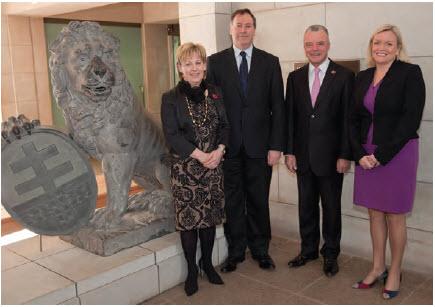
The Australian War Memorial's Corporate Management Group in front of one of the Menin Gate lions before the statues were transported on loan to the Canadian War Museum.
Left to right: Ms Rhonda Adler, Assistant Director, Branch Head Corporate Service; Mr Tim Sullivan, Assistant Director, Branch Head National Collection; Dr Brendan Nelson, Director; and Ms Anne Bennie, Acting Assistant Director, Branch Head Public Programs.
SPOTLIGHT ON THE COLLECTION
Australian War Memorial official war art
The Australian War Memorial operates the official war art scheme, the longest-running and largest-commissioning program of art in Australia. The work completed under the scheme provides a rich contribution to Australian art, while playing a significant role in Australia's interpretation of its wartime history.
In May 1917 artist and cartoonist Will Dyson became Australia's first official war artist. He received his commission at the Western Front, where he had already been working as an artist without pay or official standing since late 1916. In total, 16 men, including prominent artists like Arthur Streeton and A. Henry Fullwood, were commissioned to record Australia's war history during the First World War. They were mostly posted to France and Belgium, but George Lambert covered the Australian Light Horse in Palestine and also travelled to Gallipoli as part of Charles Bean's Historical Mission in 1919.
During the Second World War, as many as 35 artists were commissioned to travel overseas with military forces or cover a range of home-front themes. The selection of artists was diverse. Traditional artists like Ivor Hele and William Dargie were chosen alongside modern painters like Donald Friend and Sali Herman. Three women were commissioned, including Nora Heysen, who travelled to New Guinea to represent Australian nurses working there.
The scheme was reactivated on a reduced scale during the Korean and Vietnam wars. In the past 15 years the scheme has been invigorated to include 11 major contemporary artists covering both peacekeeping operations in East Timor and the Solomon Islands and the wars in Iraq and Afghanistan.
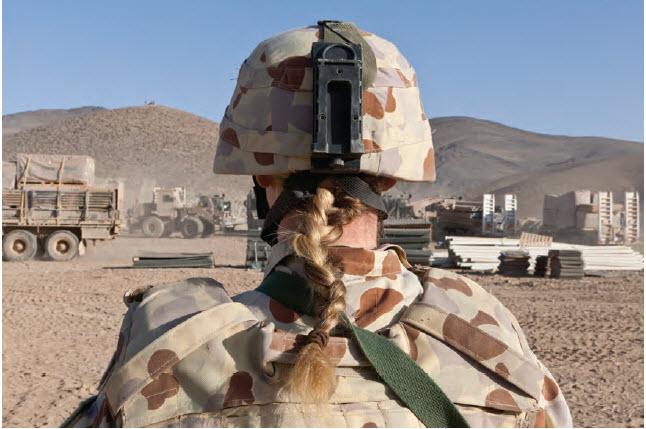
Shaun Gladwell, BPOV MEAO (Behind point of view, Middle East Area of Operations) (Digital colour photograph, inkjet on paper, 95.0 x 63.3 cm, P10015.003)
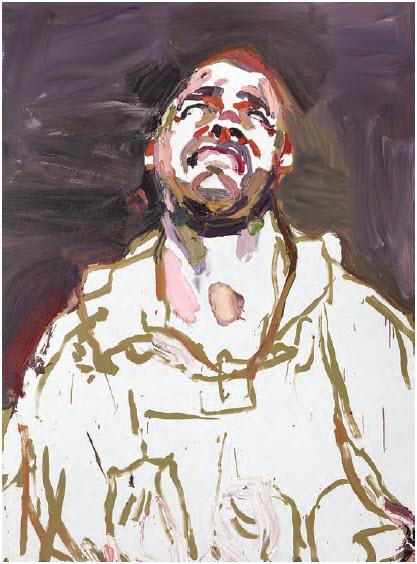
Ben Quilty, SOTG, after Afghanistan (2011, oil on linen (diptych), 300 x 140 cm, ART94522)
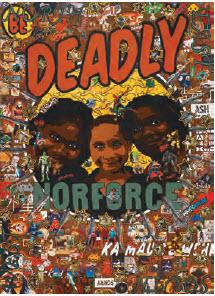
Tony Albert, Be deadly - NORFORCE (2012-13, acrylic, collage elements and mixed media print with silver leaf on paper, 140 x100 cm, ART94987)
The scheme's continuing strength and innovative outlook is apparent in the three most recent commissions. Shaun Gladwell completed his tour of Afghanistan in 2009, producing the first video works of art for the scheme. In 2011 Ben Quilty also toured Afghanistan and on his return created large-scale portraits of several soldiers who had recently served in that conflict. In these works Quilty explored the emotional and psychological effects that continue to afflict soldiers long after war. In 2012 Tony Albert was attached to the Australian Army's Regional Surveillance Unit North West Mobile Force. He is the first Indigenous Australian appointed to the role of official war artist and the first artist commissioned to work on Australian soil since the Second World War.
Four Australian War Memorial exhibitions of official war art are currently on display throughout Australia: NORFORCE: Tony Albert is on display in the Memorial's Western Courtyard Gallery until February 2015. Shaun Gladwell: Afghanistan (June 2012 to September 2014); Ben Quilty: after Afghanistan (February 2013 to May 2015); and Reality in flames: modern Australian art and the Second World War (March 2014 to June 2015) are nationally touring exhibitions.
FOCUS ON ...
Events
Carly Reid, Events and Ceremonies Coordinator, Commemoration and Visitor Engagement Section
It is 5.30 am at the Anzac Day Dawn Service. It is dark and cold but I am surrounded by tens of thousands of visitors to the Memorial, all gathered in silence to remember and pay tribute to the service and sacrifice of Australia's servicemen and servicewomen. It still amazes me how such a large number of people can stand in silence with their dimly lit candles and torches, awaiting the start of the service. I may be wearing two radio headsets and running on pure adrenaline but it is impossible not to be humbled by the reverence of the occasion and the sacred site that I am privileged to call my workplace.
I have the great honour of working in the Events and Ceremonies team at the Australian War Memorial. My background is in sports event management but I have always had a keen interest in Australia's military history, so when I saw this job advertised I knew it was an opportunity I couldn't resist. Our team is part of the public face of the Memorial and is responsible for delivering a number of events and ceremonies, including the Anzac Day and Remembrance Day ceremonies as well as Open Day and Big things in store.
There is no such thing as an average day in the Events and Ceremonies team. During my time at the Memorial I have been lucky enough to coordinate air shows, gallery launches, and VIP visits such as Their Royal Highnesses The Duke and Duchess of Cambridge. One of my most memorable experiences was coordinating the landing of helicopters on the Memorial grounds for the Open Day event in 2013.
In addition to the major events, the team delivered over 70 events and ceremonies in 2013-14 to commemorate Australia's servicemen and servicewomen, as well as over 90 VIP visits. The events and ceremonies we deliver include wreathlaying ceremonies, plaque dedication ceremonies, and exhibition and gallery launches.
Of all the amazing experiences I have had, interacting with the veterans and their families are the ones I hold closest to my heart. It is difficult to articulate the pride that our team takes in delivering ceremonies for both the veterans and the public; we invest ourselves and are often emotionally moved by what we are able to deliver and by the responses and appreciation we receive. Our part is but a small tribute to the veterans who have done so much for us and our country.
The next four years are an important time for our team and the Memorial. We are preparing for a number of commemorative events and ceremonies for the Centenary of the First World War, with a particular focus on Anzac Day 2015.
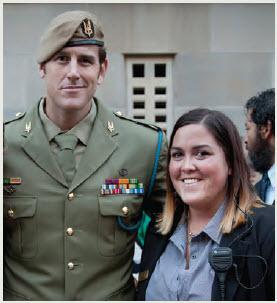
Carly Reid pictured with Corporal Ben Roberts-Smith VC MG on Anzac Day 2014.